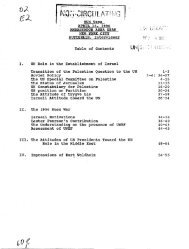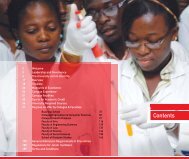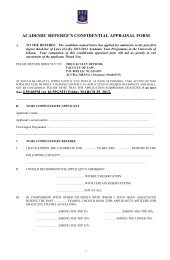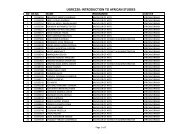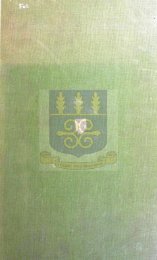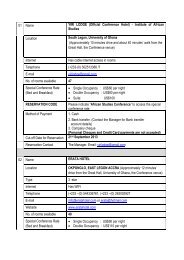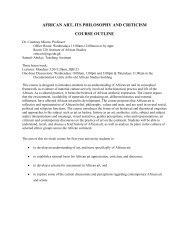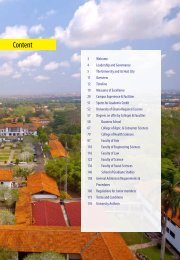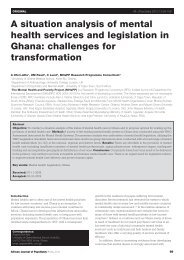View/Open - UGSpace - University of Ghana
View/Open - UGSpace - University of Ghana
View/Open - UGSpace - University of Ghana
- No tags were found...
Create successful ePaper yourself
Turn your PDF publications into a flip-book with our unique Google optimized e-Paper software.
Soil Gov.re (FQ 5H). 19UU-5 Treatments ; 9 replicates,(i) Wild canna (bidentata) (ii) Paeraria (3ij) AoioaBarteri ( iv) Clean weeding (v) Cassia alata.28. - Seed Testing. (FP). 191+1.Selected seed is planted cut for comparisonwith mixed seed from wild trees. Three methods <strong>of</strong> plantingare being tried (a) 3' x 3' x 3' planting hcles (b)ditto with heavy mulch in dry season (c) planting hcle3' square, 5' deep. Lower 2 ! feet <strong>of</strong> earth not replacedin hole, so that planting level is 2' below surface.This practice has been found (Sampson) successful withcoconuts in Ceylon in preventing subsequent baring <strong>of</strong> roots.29. Spacing Trials. Various Blocks. 120 acres. 191+2.6 Spacings : 12 replicates, Densities vary fram 22 to. - 111+ per acre.Triangular ( i) 21' ( ii) 25' (iii) 30' ( iv) 1+2'Square (v) 12' x 65' (vi) 21 f x 65' (vii) 30" x 65'(viii) 21 ' x 1+0 1 .Three covers (a) Elephant grass (b) Bush (c) Pueraria, areestablished. An estimate <strong>of</strong> the number <strong>of</strong> cattle thatcan be grazed on the covers is being made. Ultimatelythe area will be grazed and intercropped, using ploughs,between rows.Covers were planted in 191+2 t palms were planted in191+3, but wholesale replanting has been needed during 191+5.The reasons for such heavy failure are not fully known.Losses from bush-rats have been high, and every plant mustbe protected by a wire screen. Attempts to screen <strong>of</strong>fplots or portions <strong>of</strong> plots by stake hedge6 were not successful.30. Pcllina tion. The method <strong>of</strong> Hill and Mason (1925)modified by Smith (1929) has been further improved. Twcdays before they are judged about to- open male and 1 femaleflnwers are bagged after sterilisation with 1+ per cent formalin.Stout canvas bags with a celluloid observationwindow (or during war-time with a retractable corner) areused. ' The stem is trimmed and the Dag tied with its mouthfitting around a cotton-wool collar. Male flowers, whenfully open, are cut <strong>of</strong>f below the bag and- carried to thelaboratory, where the pollen is sifted and stored in smalltubes (selection) or Petri dishes (mass pollination) kept in0 desiccator. Female flowers are pollinated cne day beforethey appear receptive, and on the two succeeding days.Pollen is blown by an insufflator through a hole in thecelluloid window, which is then resealed by a plaster patch.Bags are left in position until all the stigmas are -withered(one to three weeks).!51. /



